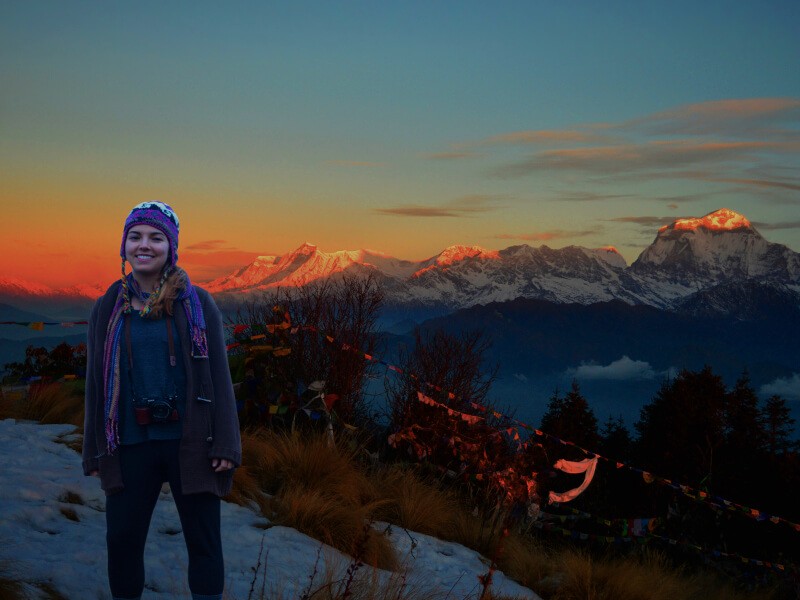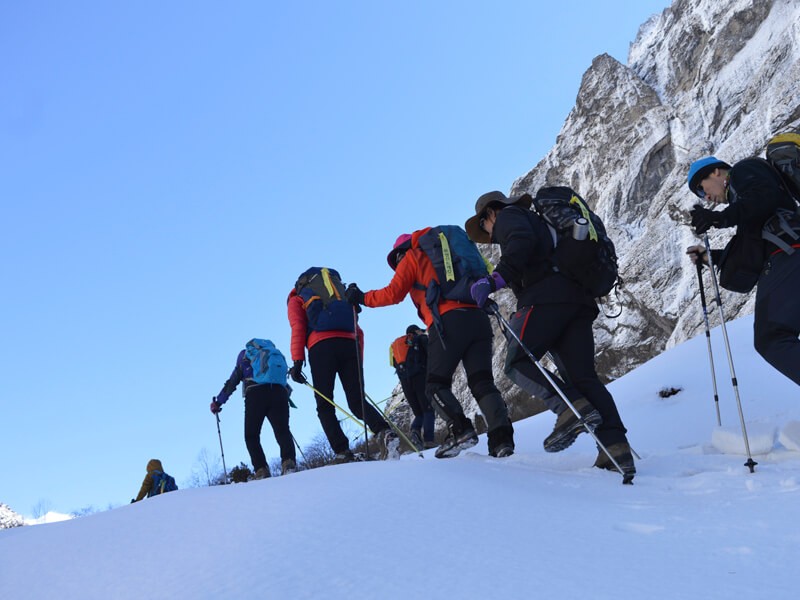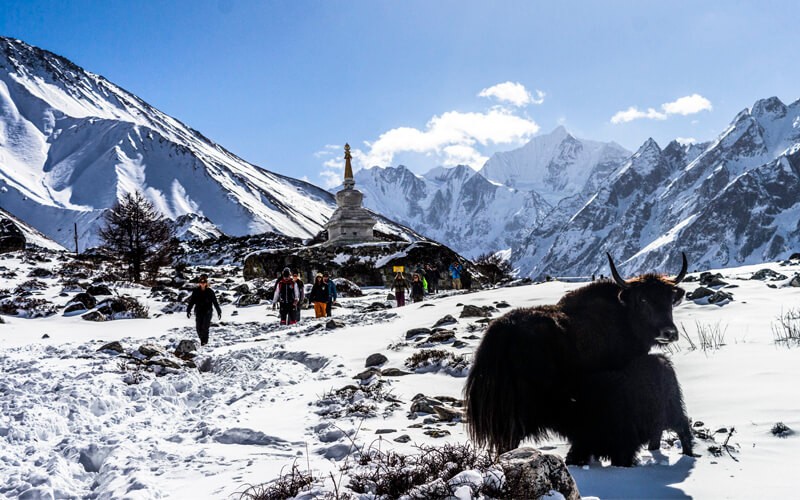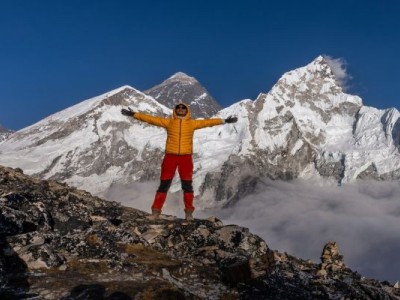As the winter blankets the Himalayas in a blanket of pristine snow, Nepal becomes a beautiful wonderland, with some of the best winter trekking in the country. While many travelers believe the cold season is not a good time to trek the mountains, winter offers trekkers a unique opportunity to enjoy views of the mountains free of haze and clouds, with fewer people, and a chance to engage with local cultures. In Nepal, the winter season typically lasts from December to the end of February each year, and sometimes extends into early March after the winter season ends. The skies are usually clear during this period, and vistas across snow-capped mountains will typically be visible, whereas in the monsoon months, clouds generally block beautiful views. This guide to the best winter-friendly trekking destinations in Nepal gives you everything you need to know about the best treks, how to prepare for trekking in Nepal in winter, and what to expect from trekking in Nepal’s cold and often magical season.
Table of Contents
Winter trekking in Nepal
Himalayan Ecological Trekking Agency offers a bounty of trekking options in winter, which are full of snowy paths and glorious views of snow-clad mountains.
Suppose you are searching for winter treks in Nepal. In that case, Ghorepani Poon Hill, Annapurna Base Camp, Mardi Himal trek, Everest panoramic trek, Langtang Gosaikund, Mustang & Rara is the most beautiful & even more popular a winter trek in Nepal. Trekking in winter in the Himalayas can make your winter season memorable and refreshing for the New Year.
Join the Himalayan Ecological Trekking and relish the walking journey to the Himalayas. We bring you the best Himalayan winter treks that will get you, pack your bags, and will give you the required push to get on these amazing treks.
What Are the Major Winter Months in Nepal?
A good understanding of the winter season in Nepal will greatly help you plan your trekking journey. Winter in Nepal has its own identifiable months when temperatures drop significantly, particularly at altitude.
January is when winter in Nepal begins. The air is crisp and dry, with daytime temperatures at lower elevations being comfortable, and the nights are cold. The clarity of the mountain views is exceptional this month.
January is consistently the coldest month of the year, and high passes may receive significant snowfall. In January, temperatures are likely to drop below freezing, particularly early morning and evening, but the skies will be very clear.
February is that delicate transition to spring. Temperatures are still cold, but now and again a few tenths of a degree will warm things up, particularly at the end of the month. February is an excellent month for trekking, as it balances winter-like conditions and some markedly warmer weather.
The early spring weather (early March especially) provides an excellent compromise for trekkers because you get winter-like clarity but not the extreme cold. The weather is stabilizing after the winter season, and beginning in March, you will see flowers blooming at lower elevations.
Winter Trekking Destinations in Nepal
Nepal boasts many trekking trails perfect for winter trekking. Here are the best trekking places in Nepal for winter trekking that feature convenience, safety, and stunning scenery.
Mardi Himal Trek
The Mardi Himal Trek is one of the best shorter options for trekking in Nepal during winter. This is a new trail that meanders through rhododendron forests and alpine meadows to the base of Mardi Himal (5,587 m). This trek typically takes 5-7 days and offers amazing views of Machapuchare (Fishtail Mountain) and Annapurna South. Winter allows for incredible visibility of the mountains, but trekkers should be prepared for snow on the higher aspects of the trek.
Ghorepani Poon Hill

The Ghorepani Poon Hill trek is one of the most popular and classic short treks in Nepal. In a short period, you will get the big chance to experience Nepal Himalaya, during the hiking time, you pass through beautiful traces fields, Local villages & green lush Rhododendron forest, and panoramic views of the most famous peaks from Poon hill Dhaulagiri, Dhampus peak, Nilgiri, South Annapurna, Fishtail and many more.
Ghandruk village is the most famous typical village & Gets in touch with the local ethnic group of Gurung People.
Therefore, trekking enthusiasts who occasionally would love to joy in the beauty of nature should try trekking in Nepal and make some remarkable memories to last for a lifetime.
Annapurna Base Camp Trek

Annapurna Base Camp trek most of the thrilling adventure trek in Nepal. This is a short time that wants to collect big and memorable experiences adventure trek in Nepal. Where you will do 10 days trek in Himalayans through beautiful Gurung village, terraces field and Himalayan alpine forest with rhododendrons forest, and panoramic views of Annapurna’s Himalaya include fishtail surrounding you.
Annapurna I which is standing in front of you, where you will be in Annapurna base camp the best to see the Annapurna I and 360-degree mesmerizing views of the Himalayas including the 10th eight thousand peaks.
Annapurna Base Camp Trek or also called the Annapurna Sanctuary Trek to join Himalayan Ecological Trekking. We will take you to the most alluring trekking region of Nepal with quality logistics and loyal hospitality. Make some remarkable adventure trekking memories to last for a lifetime.
Langtang Valley Trek

The Langtang valley trek is one of the most popular and easy trekking destinations near Kathmandu valley. The Langtang village was divested hit by a massive Earthquake in 1015 after that many Trekkers and organizations helped local people build the house. The guardian said Langtang valley is safe for trekking in Nepal published in December 2016.
The winter hiking lovers in the Himalayas Langtang valley are the best for the short and sweet holiday adventure destination in Nepal. The Langtang valley is the most beautiful valley bound by the Himalayas of Nepal, you can do a week's trek from Kathmandu to Kathmandu. During the trek, you will see the panoramic Himalayas, green lush forest, local peoples, and their culture which is similar to Tibetan culture, birds, and wild animals like musk dear, barking dear, Langur monkey, Leopard, and most beautiful rare animal Red Panda.
The trekking starts from Kathmandu and drives to Shyapru Besi after the trek start via lama hotel, Langtang village to Kyanjin Gumba. Through the beautiful traces, forest, flow the river and beautiful villages. During the week trek, you will feel the amazing experience with local people and adventures hiking during the winter season with snow path trekking.
Khopra Danda Trek
The Khopra Danda Trek provides trekkers with a quieter option to the classic Poon Hill route. This route offers a longer variation of a trek in more remote territory with magnificent views of both the Annapurna and Dhaulagiri massifs. Plenty of trekkers relish the quietness of winter trekking and the stunning beauty of trails covered in untouched snow, but the trail in winter is physically demanding.
Langtang Gosaikunda Trek
The Langtang Valley is often known as the “Valley of Glaciers” and contains some of the finest Himalayan scenery, just north of Kathmandu. Winter brings the Langtang Valley into a wondrous snow-covered landscape filled with sweeping, traffic-free views of Langtang Lirung (7,227m), along with other prominent peaks. The Langtang Valley trek is 7-10 days long, traveling through traditional Tamang villages with important cultural stories.
The revered Gosaikunda Trek leads to high-altitude alpine lakes that freeze solid in the winter. The frozen lakes make for a unique terrain characterized by a mystifying atmosphere. This site also holds spiritual significance as a popular destination for trekkers and pilgrims. The hike poses greater challenges due to winter conditions, requiring proper gear and acclimatizing, but it contributes to a compelling experience with frozen lakes and mountains dusted by snow.
Tamang Heritage Trail
The Tamang Heritage Trail focuses more on cultural exposure than extreme altitude. The trek includes a meander through traditional Tamang villages that hug the Tibetan border, exposing trekkers to authentic homestays and traditions. As most of the treks are at lower elevations, winter provides logistically easy trekking conditions with clear views of the mountains.
Chisapani Helambu Trek
The Chisapani Helambu Trek is a superb introduction to Himalayan trekking without traversing extreme altitudes. The circuit north of Kathmandu exposes trekkers to terraced farmlands, forests, and Sherpa villages. The winter weather is mild at those elevations, providing accessibility to less experienced trekkers.
Tsum Valley Trek
Located in the far northern section of the country, the Tsum Valley Trek leads you into a sacred Himalayan pilgrimage valley. This restricted area houses an ancient form of Buddhist culture and a stunning mountainous environment. Winter is a great time because of the clear skies and significantly fewer trekkers, though this trek does require special permits and a good level of preparedness for cold weather.
Everest Base Camp trek,
One of the most iconic treks of the region, the Everest Base Camp Trek becomes increasingly difficult during the winter season, but the experience can yield some awe-inspiring views and solitude for the trekkers who can endure the experience. Conditions are best in December and early January, as late January and February lead to extreme cold temperatures and high passes being possibly neglected due to snow. Only highly experienced trekkers with the proper equipment should consider attempting this trek during the winter.
Why You Should Trek in Nepal in the Winter Season
Nepal winter trekking has its own qualities that make the cold temperature worthwhile.
Clear Mountain Views: The winter air is exceptionally dry and clean, which will provide the sharpest, clearest views of the Himalayas. You will be able to see the peaks from incredible distances away, and the snow-capped peaks of the mountains look even more dramatic against the deep blue sky.
Fewer Trekkers: In the autumn, there are popular trails that feel congested, but in the winter, they can feel empty or peaceful. You will often have teahouses to yourself, there will typically be less interaction with other trekkers, and you will have a chance to interact with locals, perhaps not seeing other trekkers on the route to your destination.
Authentic Cultural Experience: There are fewer tourists in the winter, so your opportunity for genuine interaction with local communities and dialogue is expanded. Since it is winter, locals have more time to share their culture, history, traditions, and hospitality with you.
Lower Prices: If a teahouse or lodge is open in the winter, it will often offer discounted rates during this time to attract visitors. You will often be able to negotiate lower prices for accommodation than during any other season, creating better value.
Stable Weather Patterns: In contrast to the monsoon season, the winter brings extended periods of settled and dependable weather - mornings frequently start clear, and while it might be cold, drier conditions are more comfortable than wet, rainy conditions.
Unique Snow Landscapes: The landscapes at high elevation turn into stunning winter vistas. The combination of snow-covered trails, frozen waterfalls, and ice formations creates stunning landscapes that you will not find in any other season.
Personal Finance Reward: Completing a winter trek in Nepal is a testament to endurance and perseverance. The extra challenges of winter make the accomplishment of arriving at the intended destination that much more rewarding.
How to Prepare for the Winter Trek in Nepal
It's important to be well prepared for a safe and enjoyable winter trekking destination of Nepal. There are a number of comprehensive steps to take to ensure you're prepared for cold conditions.
Physical Preparation
Start cardiovascular training at least two months before your trek. Exercise and acclimatization to carrying a weighted backpack should be your main activity (stair climbing and longer hikes to build endurance). Winter trekking will require more energy from the body due to the conditions of cold temperatures, so developing stamina will be very important.
Gear, Clothing, and Equipment
Spend money on quality cold gear. Essential items to consider obtaining include:
- Four-season sleeping bag rated to -15°C or below
- Insulated and waterproof jacket and pants
- Multiple thermal layers—base layer, mid-layer, and outer layer
- Insulated trekking boot with excellent ankle support
- Two pairs of warm gloves, thermal socks, and a wool hat
- Down jacket at higher elevation
- Sunglasses and sunscreen (remember snow intensifies the effects of UV on eyes and skin)
- Trekking poles for navigating on snowy and icy surfaces
- Headlamp with extra batteries (cold conditions require it to use battery life).
Acclimatization Strategy
Add extra acclimatization days to your itinerary. Cold weather can obscure symptoms of altitude sickness, so ascend slowly and pay attention to your body. Spend additional nights at intermediate elevations before attempting to go higher.
Route Research
Research your trail thoroughly. Know which sections are harder in the winter, where you can bail out, and where teahouses are open. Not all lodges run in the winter.
Travel Insurance
Get comprehensive travel insurance that covers high altitude trekking and emergency helicopter evacuation. Check that your policy is still valid in the winter months and at your maximum planned elevation.
Hydration and Nutrition
Bring calorie-dense snacks, in addition to your food supply, and a way to purify water. In cold weather, you will feel less thirsty; nevertheless, you have to drink more at higher altitudes. Consider bringing electrolyte supplements and insulated bottles that won’t freeze.
Hiring Guides and Porters
Think about engaging professional guides who have experience in winter conditions; they understand weather patterns, know which places remain passable, and have clear-cut responsibilities regarding safety. Porters alleviate energy consumption by carrying laborious gear.
Flexibility
Include flexibility in your scheduling. Winter weather can change within the region in hours, and trip extensions might arise due to snow, trail conditions, or acclimatization needs. You should not book a flight re-entry that is tight.
Communication
Use a strong cellular plan, bring a spare phone, and charge. Report your excursion itinerary to someone you can trust. Rent a satellite phone for remote treks that have redundancies for cellular coverage.
Frequently Asked Questions
Is winter trekking in Nepal safe?
Winter trekking is safe if you prepare well, select suitable routes, and are responsible with respect to the weather. Lower treks such as Poon Hill and Mardi Himal are especially safe, while higher passes require more caution and experience.
What is the best month for winter trekking in Nepal?
December and early January typically offer the best weather and the least cold. It does get a bit warmer in February as winter begins to move toward spring.
Do I need special permits for winter trekking?
You will need the same permits that you would need for the other times you are trekking, which typically include TIMS (Trekkers' Information Management System) cards and also regional park permits. Restricted areas (Tsum Valley) will require additional special permits.
Will teahouses be open for winter trekking?
Most teahouses on popular trekking routes will stay open, although on some treks, lodges at the highest altitudes may close. Research your planned route and have a backup plan for accommodation. The guide/porter can also make calls in advance to reserve or check whether lodges will be open on your planned route.
What temperature should I expect?
Temperatures change a lot with elevation. At lower elevations (below 2,500m), daytime temperatures could be in the range of 10-15°C, dropping to 0-5°C at night. At higher elevations (above 3,500m), you can expect daytime temperatures of around 0-5°C, dropping to temperatures of -10-20°C at night or even lower.
Can beginners do winter treks in Nepal?
Yes, beginners can complete lower elevation treks such as Ghorepani Poon Hill or Chisapani Helambu with adequate preparation and gear. Do not attempt higher elevation treks with passes over 4,000m without prior trekking experience.
What about altitude sickness in winter?
Altitude sickness can occur year-round, and is not worse in wintertime. Cold weather can disguise altitude sickness symptoms. Because of this, you must be extra careful and pay attention to how you feel. You should always gain altitude gradually, hydrate well, and descend if you develop serious symptoms.
Conclusion
The ultimate trekking destination for winter-friendly trekkers in Nepal is waiting for those who are brave enough to withstand the cold. The classic trek of Poon Hill, or the more adventurous trek into Everest Base Camp, offers trekkers gorgeous skies, stunning snow-capped peaks, and peaceful trails in winter when Nepal's mountains become a pristine paradise. The cold does require respect, preparation, and an understanding of your limits. But, the rewards of trekking in winter can be uncontested- views that allow for unobstructed perspectives of the mountains, authentic interactions with locals, and the indescribable feeling of completing your journey in the Himalayas when they are at their most dramatic.
Whether you are a first-time trekker visiting each town at lower altitudes or you are a seasoned mountaineer tackling high passes, winter trekking in Nepal has something special for everyone. The combination of breathtaking scenery, fewer trekkers, and the highly stable weather creates conditions perfect for those prepared and equipped. Remember- train in advance, procure the right gear, allow for flexibility in your itinerary, and always respect the raw power of the mountains.
Trekkers in winter to Nepal are not only about reaching a destination; it is also about witnessing the beauty of the Himalayas in their most pure and dramatic form. Prepare well, bundle up, and discover why the best winter trekking in Nepal creates memories to last a lifetime.
Join the Himalayan Ecological Trekking; we will take you to the most Beautiful Langtang Valley trekking region of Nepal with quality logistics, loyal hospitality, and remarkable adventure trekking memories to your life experience within a short time trekking in Nepal.
Inquire Now: [email protected]
Expert Consultation: WhatsApp: +977 9851006023 (Bikesh)
.jpg)


